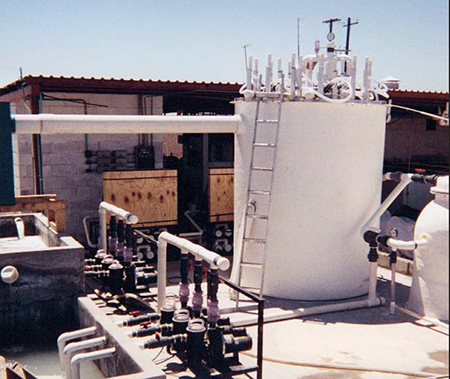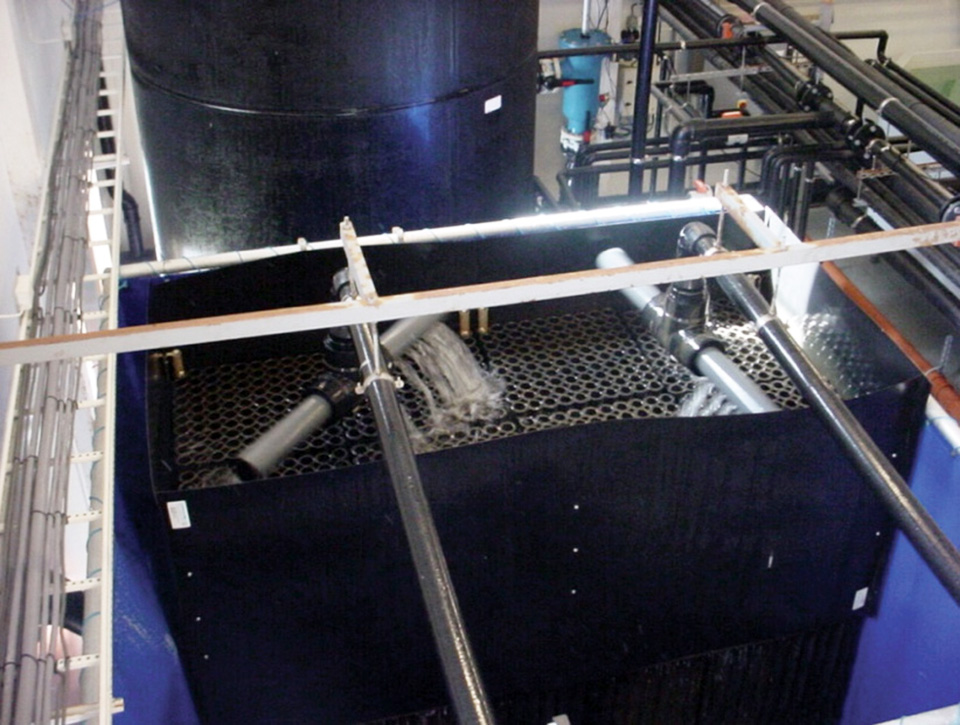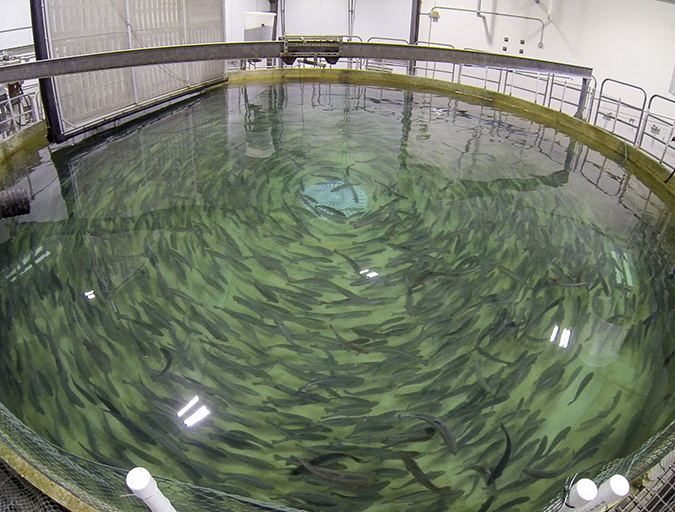Recirculating systems require regular backwashing of filters and routine checking of sand, sump tank levels

The aquaculture industry is moving rapidly towards recirculating systems for improved biosecurity, more efficient heating and cooling, reduced pumping costs, and more stable water quality.
This shift requires an increased awareness of the filtration equipment needed to attain the intended water quality in the most economical way.
Careful design criteria and management techniques must also be considered when implementing recirculation. This article discusses general recirculating system design and management considerations, with special emphasis on fluidized bed biofilter technology and its applications in aquaculture systems that demand high water quality.
Fluidized bed biofiltration technology for oligotrophic water quality
When designing a recirculating system it is essential to consider the most cost effective filtration system for the desired water quality. For “oligotrophic” (low nutrient levels) systems, where extremely high water quality must be attained, biofilters with low cost per cubic foot of media and high surface area per unit volume must be considered. This is where fluidized bed filters really stand apart from other filters.
The fine sand media in a fluidized bed biofilter provides an extremely high surface area (7,800 square feet) and acts as a thin film reactor. This enables the biofilter to remove up to 100 percent of the ammonia per pass and allows the system to be shock-loaded without any changes in overall water quality. In addition to nitrification, between 200 and 1000 different bacteria species can flourish in the sand media, which keeps water in the system biologically stable.
A mechanical filter must be used in series before the fluidized bed biofilters, to remove the suspended solids and maximize performance of the fluidized bed. A propeller washed bead filter is recommended for this application, because of its effectiveness in removing particles down to 15 μ in size as well as low water discharge during backwashing.
Since the nitrification process requires two ppm of oxygen for every one ppm of ammonia removed, we must include aeration in our recirculating system design. Re-saturation of oxygen as well as off gassing of CO2 can be accomplished in a single pass through a packed column. The packed column can be placed at the exit of the fluidized bed filtration system, which will require no additional energy or expensive equipment.
Water sterilization and disinfecting equipment, such as a UV (ultraviolet) sterilizer and a protein skimmer, can be used in a recirculating system to further improve the quality and clarity of the water. This equipment would be used most efficiently after the water has passed through the filtration system.
Aquaculture applications for fluidized bed biofiltration systems
Fluidized bed biofiltration systems have proven very successful at maintaining excellent water quality for a number of different aquaculture applications. These applications include penaeid shrimp hatcheries, fish breeding centers, zebra fish genetics research laboratories, koi ponds and seafood holding systems.
The need for increased biosecurity and rising shrimp prices due to recent outbreaks of white spot virus have sparked particular interest in recirculation technology in all phases of the shrimp hatchery. Shrimp maturation and broodstock grow-out designs have been developed and are currently being used successfully. These systems can utilize water exchange rates of less than 2 percent per day, which enables incoming water to be treated and greatly decreases the risks of pathogen introduction and disease outbreaks.
Fluctuations in water quality due to red tides, rainfall and agricultural runoff are also greatly reduced. Improved stability in water quality in commercial shrimp maturation systems has resulted in increased production. In some cases, ovarian maturation now occurs without eyestalk ablation. The next step is development of recirculating systems for larviculture. This research is currently underway and awaits commercial testing.
Recirculating system design and management

The implementation of this new technology requires careful design and management. The new system must be properly sized for the desired water quality, taking into consideration the total water volume, daily feed rates, and biomass in the tanks. The flow rate should allow the water to pass through the filtration system every three hours in order to eliminate ammonia completely each pass.
The system itself should be designed to allow biologists to work with the animals without added constraints. For example, plumbing should allow for medicating, draining and cleaning of tanks without interfering with the rest of the system. The water discharge from these operations must be diverted to the waste drain and not sent to the biofilter. When integrating a recirculating system into an existing flow-through system, careful design must also allow the flexibility of using either system.
The flow diagram should be designed efficiently by using gravity to move water whenever possible, and for ease of operation and maintenance. Valves should be either open or shut and not adjusted by operators to balance flow rates. Additionally, the system should rely on mechanical operation, not electronics, to control water levels in the sump tanks.
It is also very important to the success of the system to anticipate problems before they occur. For example, a stable electrical supply and a backup generator are very important to keep the system running. Sump tanks must not only be sized properly for operation, but also for dynamic head in case of a power outage. If the dynamic head is not taken into consideration, the tanks may flood the room and burn a pump when the system starts back up. Sump tanks must also be designed with overflows to allow tanks to be taken off line when necessary.
Recirculating systems also need to be managed carefully for optimum performance. This will require regular backwashing of filters and routine checking of sand and sump tank levels. Acomplete maintenance log must be kept up to date. Regular testing of ammonia, nitrite, and pH is also required. In commercial hatcheries, a dedicated, water quality manager may be needed to keep careful records and make important system management decisions.
Conclusion
Fluidized bed biofiltration systems have successfully provided consistent, high quality water for a number of different aquaculture applications, such as shrimp maturation systems. With the anticipated development of recirculating systems for larval rearing, shrimp hatcheries may soon become independent of ocean-front sites. An awareness of the careful balance that exists in a recirculating system, coupled with sound design and proper management, is needed to keep the system running without fail for many years. The initial capital investment in fluidized bed recirculation systems may seem high, but it is a proven, long term, and sustainable solution for aquaculture systems that demand high water quality.
(Editor’s Note: This article was originally published in the June 2000 print edition of the Global Aquaculture Advocate.)
Now that you've reached the end of the article ...
… please consider supporting GSA’s mission to advance responsible seafood practices through education, advocacy and third-party assurances. The Advocate aims to document the evolution of responsible seafood practices and share the expansive knowledge of our vast network of contributors.
By becoming a Global Seafood Alliance member, you’re ensuring that all of the pre-competitive work we do through member benefits, resources and events can continue. Individual membership costs just $50 a year.
Not a GSA member? Join us.
Author
-
Sam Courtland
Aquaneering, Inc.
8280 Clairemont Mesa Blvd.
Suite #117
San Diego, California 92111 USA
Tel: 858-541-2028[109,111,99,46,103,110,105,114,101,101,110,97,117,113,97,64,99,109,97,115]
Tagged With
Related Posts

Innovation & Investment
A review of unit processes in RAS systems
Since un-ionized ammonia-nitrogen and nitrite-nitrogen are toxic to most finfish, controlling their concentrations in culture tanks is a primary objective in the design of recirculating aquaculture systems.

Innovation & Investment
Getting proficient in RAS fundamentals
A number of large salmon farming companies are now investing significantly to increase land-based, water recirculating aquaculture systems (RAS) in northern Europe and North America, and there is likely a need for more trained farm personnel to run and manage these and other close-containment aquaculture facilities.

Health & Welfare
New approaches can help ensure safety of raw farmed oysters
Practical post-harvest oyster processing methods are needed. Preliminary studies evaluated the potential of high-salinity relaying to control Vibrio levels in raw oysters.

Responsibility
Constantly changing pH unavoidable, completely normal
Prof. Claude Boyd discusses the importance of pH for farmed fish and shellfish, the normal and natural fluctuations and how aquaculture systems can manage it.



